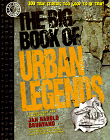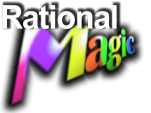|
GENRES:
Nonfiction (sort of), folklore, reference
AUDIENCE:
Adults, teens; some adult situations; some graphic scenes, but
little direct gore; little profanity.
SYNOPSIS:
This book adapts some 200 urban legends into comic form. The
legend forms are divided into "Moving Violations" (car-related
legends), "Wild Kingdom," "Campfire Classics"
(the horror stories we told one another around the campfire and
at sleepovers), "Comic Calamities," "Caught in
the Act" (sex and scandal), "Crimes and Misdemeanors,"
"Occupational Hazards" (business, government, and professional
legends), and "FOAF-a-Rama" (miscellaneous). Most legends
are told in a single page of eight or nine black-and-white panels;
only a few legends earn two pages.
EVALUATION:
I love urban legends and am pretty well versed in them. This
book is amusing but disappointing. The legends themselves are
worth reading (and you have to wonder how anyone can be stupid
enough to believe many of them). Some I’ve heard told as
jokes, not as true stories. However, the sameness of the artwork
began to get on my nerves after a while. You’d think that
with "200 of today’s most popular comic artists"
there would be a lot of artistic variation, but relatively few
of the adapted legends stand out from the crowd. There seems
to have been an attempt to emulate the old EC horror comics style
(down to the "Good lord! <choke>"), but most
of the contributions are too artistically bland to succeed at
this. The storytelling is occasionally ham-handed, thanks to
the attempt by the adapters to turn some legends into first-person
or third-person narratives. Finally, in some pieces the story
is not clear; the combination of art and text fails to explain
why some things worked out the way they did. Some stories, in
fact, are confusing if the reader doesn’t read their titles.
For the more scholarly among us, this publication has little
in the way of interpretation or evaluation of the legends. The
introduction by Brunvald, the man who popularized the study of
urban legends, is just a quick history of his involvement with
the legends, his publication history, and his approval of adapting
the legends into comic form. Nor is there any real organization
(subject or title indexes would have helped) within the book.
Overall, a lightweight effort, pleasant enough in small doses. |



